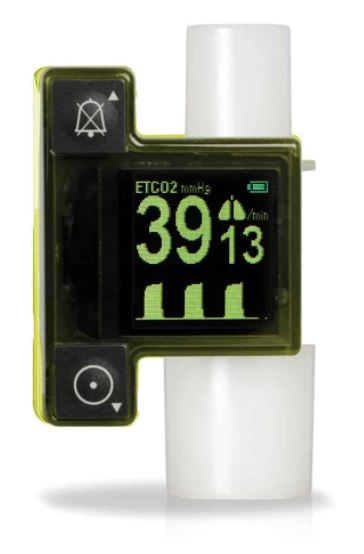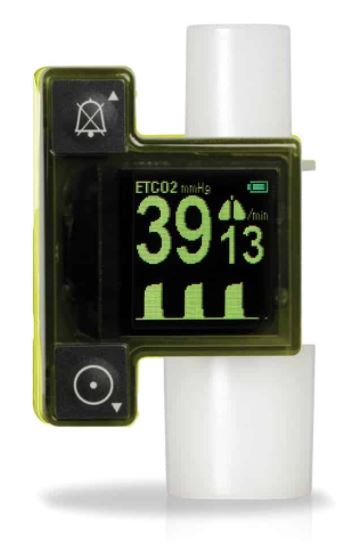CAPNOGRAPH, handheld, battery (Emma) mmHg
Valid Article
CAPNOGRAPH (Emma)
Definition
A battery-powered device intended to continuously measure the concentration of carbon dioxide (CO2) in a gas mixture through infrared absorption, to determine a patient's ventilatory, circulatory, or metabolic status. It is typically used to measure end-tidal carbon dioxide (EtCO2) in expiratory gases during administration of mechanical ventilation and to confirm proper endotracheal tube or other airway device placement. Commonly known as a capnograph or a capnometer, the sampling method is "mainstream" through the Airway Adapter. This adapter is fitted with optical windows that are transparent to light in the wavelength ranges of interest.
Synonym
Carbon dioxide monitor
Specifications
Quality standards
- ISO 80601-2-55, 2018, edition 2, Medical electrical equipment - Part 2-55: Particular requirements for the basic safety and essential performance of respiratory gas monitors
- ISO 5356-1, 2015, edition 4, (confirmed 2020) Anaesthetic and respiratory equipment - Conical connectors - Part 1: Cones and sockets
Quality Standards Comment
See introduction on electro mechanical medical devices
Technical specifications
- OLED-display with parameters
- ETCO2 value
- respiratory rate value
- CO2 waveform (the capnogram)
- end-tidal carbon dioxide (EtCO2)
- range: 0-99 mmHg / 0.0 – 9.9 kPa)
- values are displayed after one breath
- averaged value is updated every breath
- real-time EtCO2 waveform
- 14.4 second sweep of CO2 values
- fixed 0-53 mmHg / 0-7 kPa scale
- If the CO2 level reaches or exceeds 53 mmHg / 7 kPa, a horizontal dashed line will be displayed to indicate that the capnogram is saturated.
- respiration rate (RR) measurement
- range: 3 – 150 bpm
- RR is displayed after two breaths and updated every breath
- Battery
- 2 AAA lithium or alcaline 1.5V batteries
- up to 10 hours normal use (6 hours for alkaline batteries)
- battery status indicator on display (in the upper right corner)
- low battery visual and audible alarm, repeated every 80 seconds
- Alarm Status Indicator and an audible alarm
- may be silenced for a period of two minutes
- when an alarm is triggered, an Alarm Status Indicator in the lower right corner of the display is lit with a steady or blinking yellow light depending on the alarm priority, together with an audible alarm beep.
- Switches off automatically during the following conditions:
- No breath detected after two minutes
- After 15 seconds if the Airway Adapter is removed
- Minimal warm-up time: 15 seconds to full accuracy
- Operating Temperature
- -5 to +50°C (23 to 122°F)
- -20 to -5°C for 20 minutes
- One-touch programming
- Protection against electrical shock
- Type BF Applied Parts
- Protection against ingress of solid foreign objects and water
- IP44
- Dimensions: 5.2 x 3.9 x 3.9 cm
- Weight: 59.5 g with alkaline batteries
Supplied with the Article
Pouch and lanyard are included in the set.
To be Ordered Separately
Airway adapters are needed, they must be ordered separately
- Two sizes:
- adult/ child for > 10 kg or > 1 year
- infant for < 10 kg or < 1 year
- Single patient use
- Dead space: adult 6ml, infant: 1 ml
Instructions for use
Precautions for Use
The device may only be used for noninvasive patient monitoring!
- The device must not be used with flammable anesthetic agents
- If the device is used with a respirator or with harmful gases such as N2O, always perform a pre-use tightness check of the patient circuit.
- Do not immerse in any liquid. The device and Airway Adapters are non-sterile devices. Do not submerge the device or Airway Adapters in any cleaning solution or attempt to sterilize by autoclave, irradiation, steam, gas, ethylene oxide or any other method. This will seriously damage the device.
- Do not clean the device with any chemical other than those specified by the IPC standards
- Before cleaning, remove the batteries and make sure the battery cover is re-attached correctly.
Maintenance
- No routine calibration required
- Maintenance procedures:
- Battery replacement
- Zeroing Procedure
- Gas span check
Non-repairable device. In case of failure, follow the decomissioning procedure or contact your biomedical specialist support.
Waste management
Properly use and dispose of batteries or they may leak or explode.
MSF requirements
A portable capnograph allows to assess correct tube placement and monitor ventilation in units that don't have a multiparameter monitor and during transport of patients.





![[EANECAMC0101] (capnograph Emma) AIRWAY ADAPTER adult/pediatric, s.p.](/web/image/product.template/574738/image_256/%5BEANECAMC0101%5D%20%28capnograph%20Emma%29%20AIRWAY%20ADAPTER%20adult-pediatric%2C%20s.p.?unique=f85f0fe)
![[EANECAMC0102] (capnograph Emma) AIRWAY ADAPTER infant, s.p.](/web/image/product.template/574739/image_256/%5BEANECAMC0102%5D%20%28capnograph%20Emma%29%20AIRWAY%20ADAPTER%20infant%2C%20s.p.?unique=f85f0fe)
![[SCTDTUED25-] TUBE, ENDOTRACHEAL, s.u. + CONN., w/o balloon, Ø 2.5 mm](/web/image/product.template/573236/image_256/%5BSCTDTUED25-%5D%20TUBE%2C%20ENDOTRACHEAL%2C%20s.u.%20%2B%20CONN.%2C%20w-o%20balloon%2C%20%C3%98%202.5%20mm?unique=e1beb3f)
![[SCTDTUED30C] TUBE, ENDOTRACHEAL, s.u. + CONN., microcuff, Ø 3 mm](/web/image/product.template/570051/image_256/%5BSCTDTUED30C%5D%20TUBE%2C%20ENDOTRACHEAL%2C%20s.u.%20%2B%20CONN.%2C%20microcuff%2C%20%C3%98%203%20mm?unique=77ab501)
![[SCTDTUED35C] TUBE, ENDOTRACHEAL, s.u. + CONN., microcuff , Ø 3.5 mm](/web/image/product.template/570053/image_256/%5BSCTDTUED35C%5D%20TUBE%2C%20ENDOTRACHEAL%2C%20s.u.%20%2B%20CONN.%2C%20microcuff%20%2C%20%C3%98%203.5%20mm?unique=77ab501)
![[SCTDTUED40C] TUBE, ENDOTRACHEAL, s.u. + CONN., microcuff , Ø 4 mm](/web/image/product.template/570054/image_256/%5BSCTDTUED40C%5D%20TUBE%2C%20ENDOTRACHEAL%2C%20s.u.%20%2B%20CONN.%2C%20microcuff%20%2C%20%C3%98%204%20mm?unique=8271e28)
![[SCTDTUED45C] TUBE, ENDOTRACHEAL, s.u. + CONN., microcuff, Ø 4.5 mm](/web/image/product.template/570055/image_256/%5BSCTDTUED45C%5D%20TUBE%2C%20ENDOTRACHEAL%2C%20s.u.%20%2B%20CONN.%2C%20microcuff%2C%20%C3%98%204.5%20mm?unique=77ab501)
![[SCTDTUED50B] TUBE, ENDOTRACHEAL, s.u. + CONN., balloon, Ø 5 mm](/web/image/product.template/573164/image_256/%5BSCTDTUED50B%5D%20TUBE%2C%20ENDOTRACHEAL%2C%20s.u.%20%2B%20CONN.%2C%20balloon%2C%20%C3%98%205%20mm?unique=e1beb3f)
![[SCTDTUED55B] TUBE, ENDOTRACHEAL, s.u. + CONN., balloon, Ø 5.5 mm](/web/image/product.template/573156/image_256/%5BSCTDTUED55B%5D%20TUBE%2C%20ENDOTRACHEAL%2C%20s.u.%20%2B%20CONN.%2C%20balloon%2C%20%C3%98%205.5%20mm?unique=df29fb2)
![[SCTDTUED60B] TUBE, ENDOTRACHEAL, s.u. + CONN., balloon, Ø 6 mm](/web/image/product.template/573157/image_256/%5BSCTDTUED60B%5D%20TUBE%2C%20ENDOTRACHEAL%2C%20s.u.%20%2B%20CONN.%2C%20balloon%2C%20%C3%98%206%20mm?unique=e1beb3f)
![[SCTDTUED65B] TUBE, ENDOTRACHEAL, s.u. + CONN., balloon, Ø 6.5 mm](/web/image/product.template/573183/image_256/%5BSCTDTUED65B%5D%20TUBE%2C%20ENDOTRACHEAL%2C%20s.u.%20%2B%20CONN.%2C%20balloon%2C%20%C3%98%206.5%20mm?unique=e1beb3f)
![[SCTDTUED70B] TUBE, ENDOTRACHEAL, s.u. + CONN., balloon, Ø 7 mm](/web/image/product.template/573167/image_256/%5BSCTDTUED70B%5D%20TUBE%2C%20ENDOTRACHEAL%2C%20s.u.%20%2B%20CONN.%2C%20balloon%2C%20%C3%98%207%20mm?unique=c49852f)
![[SCTDTUED75B] TUBE, ENDOTRACHEAL, s.u. + CONN., balloon, Ø 7.5 mm](/web/image/product.template/573170/image_256/%5BSCTDTUED75B%5D%20TUBE%2C%20ENDOTRACHEAL%2C%20s.u.%20%2B%20CONN.%2C%20balloon%2C%20%C3%98%207.5%20mm?unique=df29fb2)
![[SCTDTUED80B] TUBE, ENDOTRACHEAL, s.u. + CONN., balloon, Ø 8 mm](/web/image/product.template/573173/image_256/%5BSCTDTUED80B%5D%20TUBE%2C%20ENDOTRACHEAL%2C%20s.u.%20%2B%20CONN.%2C%20balloon%2C%20%C3%98%208%20mm?unique=57ce881)